A business model (BM) describes how an organization creates and delivers value to customers. It characterizes products or services that a company provides, and the way a company is compensated for them - a revenue model. As every business model has its own structure, each containing hidden pros and cons, the purpose of this article is to analyze revenue models and discuss monetization approaches of software product companies to help you determine which one is the best suited to your product.
Distribution approach. The most important business model characteristic is the distribution approach that a company uses to provide services or create products for customers. We distinguish three main distribution approaches that can be used: on-premise, cloud, and hybrid.
Source code licensing. Based on licensing of source code the company creates, the software may be proprietary or open-source code.
Revenue streams. A software revenue stream defines the way company is paid for its products and services. A business model can make use of one or several revenue streams. For instance, software product revenue streams can include ad revenue, sales, subscriptions, and their combinations.
Business model characteristics
Despite the numerous and varied publications in the field, there is still no single classification approach to business model types and the revenue models that best match them. That’s why, instead of trying to classify a variety of unique models, we’ll define and discuss characteristics that constitute business models of software product companies. So, creating a business model of a company involves a combination of the following characteristics:Distribution approach. The most important business model characteristic is the distribution approach that a company uses to provide services or create products for customers. We distinguish three main distribution approaches that can be used: on-premise, cloud, and hybrid.
Source code licensing. Based on licensing of source code the company creates, the software may be proprietary or open-source code.
Revenue streams. A software revenue stream defines the way company is paid for its products and services. A business model can make use of one or several revenue streams. For instance, software product revenue streams can include ad revenue, sales, subscriptions, and their combinations.
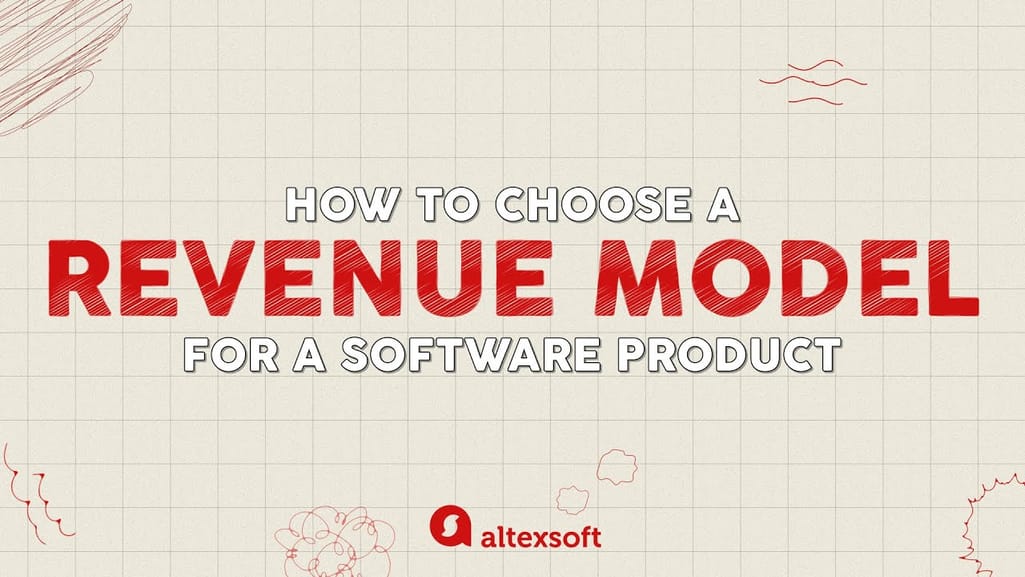

Check our video explainer on revenue models and streams
Business model interaction. Software companies inevitably choose between two types of business model interactions while forming its business model. It can take a form of one-to-many or many-to-many. The former is traditional value delivery, when a provider directly solves customer problems (Trello, Microsoft Office, Photoshop, etc.). The latter implies that a company creates a platform where both end-providers and customers meet (Airbnb, Uber, or Upwork). But more on that below.B2C or B2B market. Eventually, a company must choose the target audience that it sells products or services to, which would lead to the company taking the business-to-business (B2B) or the business-to-consumer (B2C) approach. B2B means that company sells services to other businesses and B2C means selling a product or service directly to a consumer.
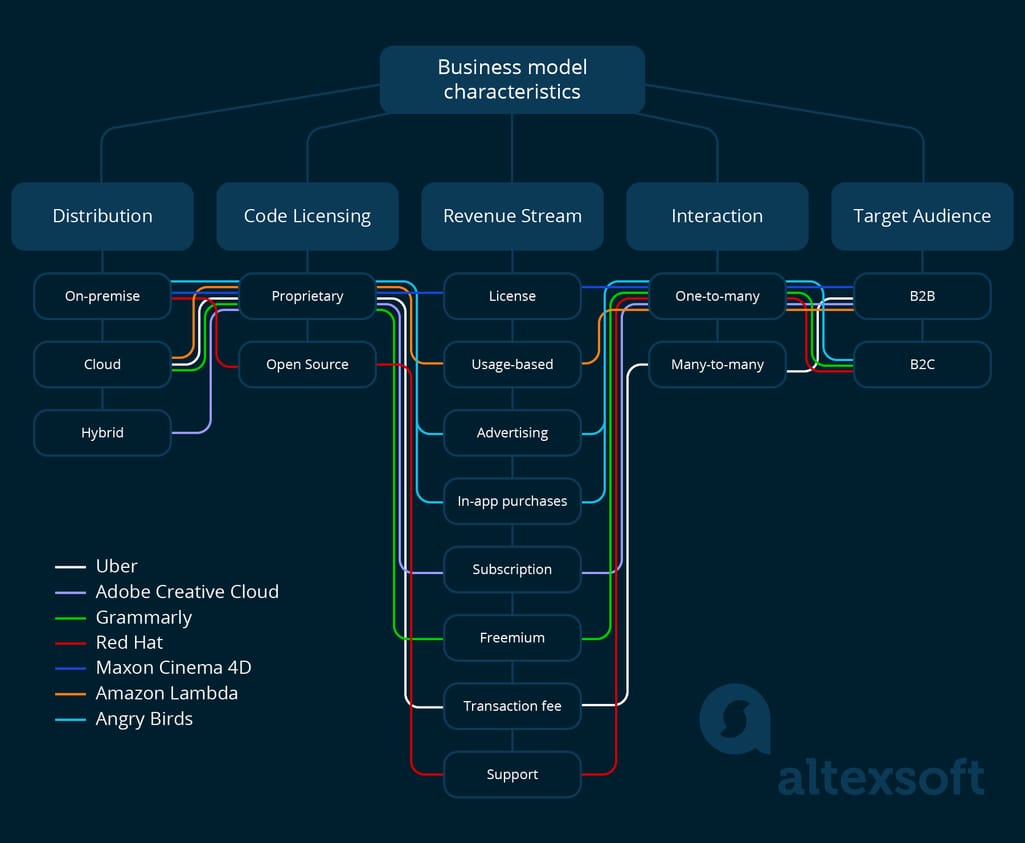
On-premises software distribution approach
The on-premises distribution approach entails a software product being installed and running within a client’s in-house infrastructure, be that a single computer or a local server. The traditional distribution approach has been used for many years by such companies as SAP, Oracle, and Microsoft.Pros of traditional on-premises software distribution approach
- On-premises deployment allows you to customize the product, aligning it with client' needs.
- It allows simple integration with a client’s other corporate systems over the intranet.
- All infrastructural expenses are covered by one client.
Cons of traditional on-premises distribution approach
- Implementation of a new on-premises environment requires a lot of time.
- The client must have its own IT support staff and in-house server hardware if you provide corporate-level software.
- These first two factors may turn potential customers towards cloud competitors.
- If a product is distributed via a license model, your clients will be hesitant about making a large, upfront investment in a license considering the risks.
- If on-premises software was customized, upgrading it becomes increasingly more complicated.
Cloud-based software distribution approach
The main characteristic of the cloud-based distribution approach is that the software runs at a hosting provider or in the cloud service.For instance, software as a service (SaaS) is a cloud-based distribution approach in which a provider hosts its applications and makes them available to customers via the Internet. According to the SaaS method, businesses and individuals don’t need to install applications on their own computers or own data centers. They can access the software using a Web browser or a mobile device. SaaS is typically delivered via a term-based subscription.
Pros of the cloud-based distribution approach
- Cloud products and services have faster implementation timeframes for clients
- Users will be able to access products and information remotely from anywhere at any time, given that they have an Internet connection
- The SaaS approach doesn’t require any initial setup costs from users. The customers just need to subscribe and log into their account to get full access to the app and its updates
- The SaaS approach gives you the opportunity to provide the same software version for all your customers. This means that you have a single version to maintain, upgrade, de bug, and provide storage support for.
- The main revenue stream of the cloud distribution approach is subscriptions,and as a result you will be able to receive revenue as long as the client uses the software, on an ongoing basis.
Cons of cloud distribution approach
- There may be compatibility issues between cloud solutions and integration with existing on-premise enterprise applications that your clients already have.
- You are fully responsible for service outages that may occur. Setting up reliable infrastructure is required.
Hybrid software distribution approach
Some software companies have a hybrid distribution approach. Hybrid in this case is the approach that combines a SaaS solution with an on-premise software application. So, a cloud-driven technology complements an on-premise one. For instance, Adobe Creative Cloud combines on-premise products like Photoshop with additional cloud services like libraries, presets, etc. Besides, on-premise software gets updated as if deployed on the cloud, regularly and without asking the client to purchase a separate license for each new version of a product. As high-speed Internet connection has become a new standard, hybrids will become increasingly more common.Another way to realize the hybrid deployment is to let customers choose between a SaaS service or an on-premises solution and provide the opportunity to switch from one to the other if needed. For example, Microsoft Outlook can be deployed on-premises but can also be accessed online.
Pros of hybrid software distribution
- It allows a client the flexibility to move information between on-premises data centers and third-party cloud services, without being locked into a particular cloud provider or their own infrastructure
- Users can take advantage of tight integration with existing corporate systems and they can also easily transfer large files regardless of their Internet speed.
- A provider can ensure seamless updates of on-premise software and distribute different features between on-premise and cloud
- Sensitive or highly regulated information (e.g. medical records) can stay on-premise, while operations that don’t involve sensitive data can be conducted in the cloud
Cons of hybrid software distribution
The hybrid approach combines and amplifies the difficulties of both SaaS and on-premise approaches.- On-premise has limited customization opportunities compared to that of a pure cloud version
- If customizations are available, updating software becomes a critical engineering challenge
- If software is accessible both from a web interface and an on-premise interface, the amount of front-end development tasks significantly increases
Source code licensing
Software companies can create proprietary or open source software.Proprietary software
In most cases, proprietary software doesn’t let the user access, change, or reuse the copyrighted source code. Even if a program is free to use, it may have proprietary code that users and third-parties can’t change. In this case, code written in a high-level language is assembled in a machine language, which is executable by a machine but unreadable by a human. Most companies make their software products proprietary to protect it from copying, changing, or emulating.There are exceptions. Sometimes, software protected by copyright does have code available for alteration by users.
Pros of creating proprietary software
- Users will be sure that the product will work properly due to a single source for support, bug fixes, security fixes, and regular upgrades
- Software is protected by copyright and can be monetized
Cons of proprietary software
- As described in the “pros” section, the owner of proprietary software is responsible for all updates, customization (if needed), and maintenance. Having a limited engineering capacity may slow down feature development compared to competing providers.
- Proprietary software may be unaffordable to a chunk of potential clients
- The code owning organization is the only one responsible for finding and fixing code vulnerabilities. So, closed-code software is more likely to be vulnerable to malware and attacks than open-source code where possible exploits can be better detected as a community effort
Open source software
Open source software means that users get software and access to source code free. Nowadays, an increasing number of technology companies create open source software. Black Duck Software, the open-source software (OSS) solution provider that helps maximize value by minimizing risks from open source software, has disclosed the results of 2016 The Tenth Annual Future of Open Source Survey. According to the research, 78 percent of respondent companies run part or even all of their operations on OSS, and 66 percent said their companies create software for customers built on open source. It’s the highest open source software usage rates of all time.At the picture below you can see that operating system, database, and development tools are the top OSS areas in 2016.
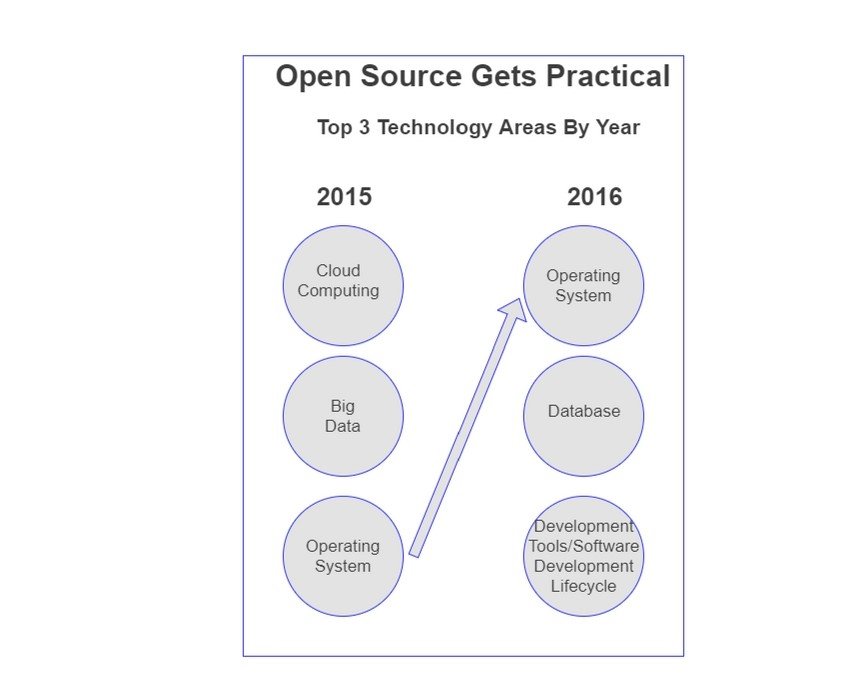
Open source technology areas
Source: Black Duck Source Software Survey
The main drivers of growing open source adoption in 2016 are the quality of OSS solutions, feature support, and susceptibility to customization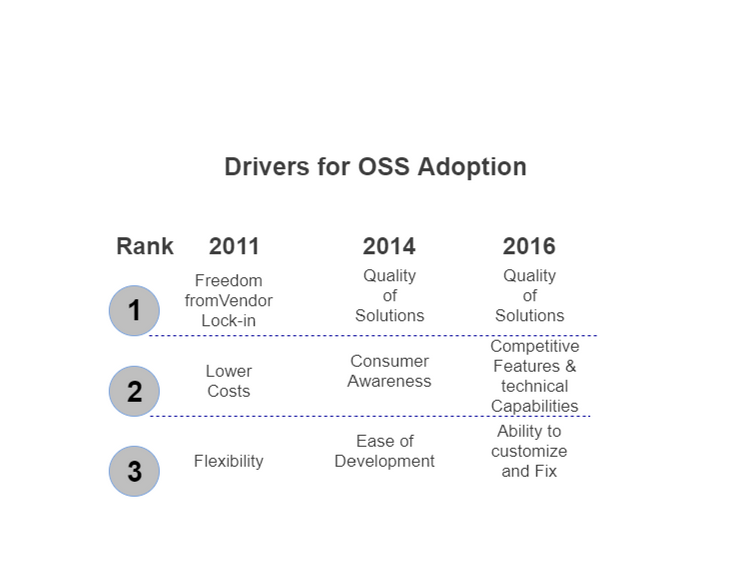
Drivers for OSS Adoption
Source: Black Duck Source Software Survey
The vendor charges for customization, support, and maintenance are traditionally the main open monetization mechanisms for open source software. A common practice of the open source projects is when the “parent” company - which is the main contributor to such a project - provides all support. This includes user support, product maintenance, hosting, consulting, and defining the product strategy.For instance, Jet Brains creates tools for developers that are used all over the world in different well-known companies such as Wikipedia, Salesforce, and Pinterest. At the same time, JetBrains is an active participant in the open source community. It has its own open source projects and JetBrainers make commitments to non-JetBrains open-source projects. For example, PyCharm is a product developed by JetBrains. PyCharm is the integrated development environment (IDE) used in computer programming, specifically for the Python language. This IDE has the Community Edition which is released under Apache License and the Professional Edition released under a proprietary license.
Kotlin, IntalliJ Platform, MPS are the open source JetBrains projects.
Pros of creating open source software
- OSS is a great opportunity to present the innovative features and technical capabilities of your product to attract more users.
- Clients can customize a product for their needs.
- OSS is a good way to improve brand recognition among technology companies
- As mentioned above, OSS has less chance of having vulnerabilities as they can be detected by a community
Cons of open source software
- Many corporate clients will struggle to create formal policies for selecting and approving open source code
- Creating open source products require finding additional revenue streams
Revenue streams
Generally, most software companies have a hybrid mix of revenue streams to meet different market needs. The revenue streams below aren’t mutually exclusive, so it’s possible to mix them and use more than one to balance between two main goals: gaining users and increaseing revenue.Paid apps and license
The concept of a license-based revenue stream entails a provider charging a customer money once for installing software. This is probably the most common and simple monetization approach widely used with on-premise products.On the other hand, a finite price can also be a barrier for you to gain a large number of users due to the competition with free and open source analogs. If you want people to purchase your product, you should demonstrate to them its high value.
In a traditional on-premises distribution approach, a one-time upfront, perpetual license fee is used, which gives customers the right to use the software indefinitely. However, technical support and the right to product updates can be priced separately in some cases, especially for professional software.

For instance, the Cinema 4d, 3d modeling and animation package requires paying for each new version even if a customer has paid a full price for a perpetual licence
Examples: Cinema 4D, ADW Launcher EX, Minecraft.Free, with in-app advertising
In-app advertising allows you to make money by selling advertising space in your application. However, this means of monetization will be the smart choice only if the implementation is done correctly and you deliver the relevant advertising content. The more personalized advertisements you make, the more revenue you will derive from it.Examples: Angry Birds, Facebook, Twitter.
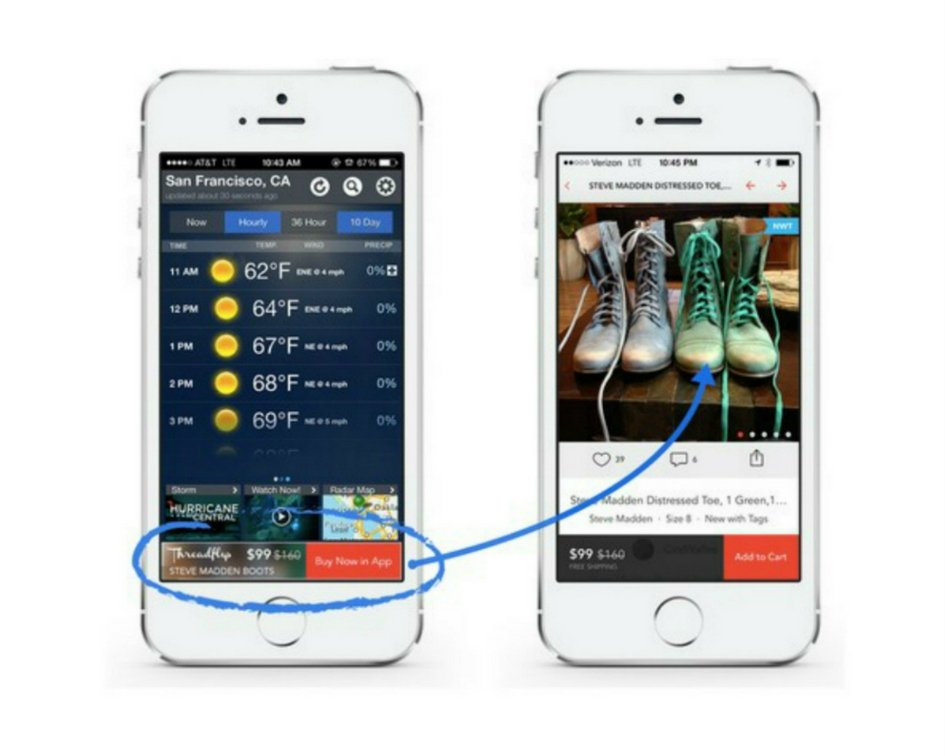
In-app advertising
Sponsorship. Sponsorship is a subtype of an in-app advertising monetization stream. According to the sponsorship strategy, you agree to become a partner with an advertising company which will provide users of your product with some rewards for completing certain actions in your app. Brands and agencies pay you to be a part of an incentive system. This way, you receive a certain part of the revenue from redeemed rewards. At the same time, incorporating advertising into your app will increase your app’s ability to engage users.For instance, RunKeeper motivates its users to track running activity with their app using incentive advertising. If the users track their running with this app, they will unlock exclusive rewards and promotions.
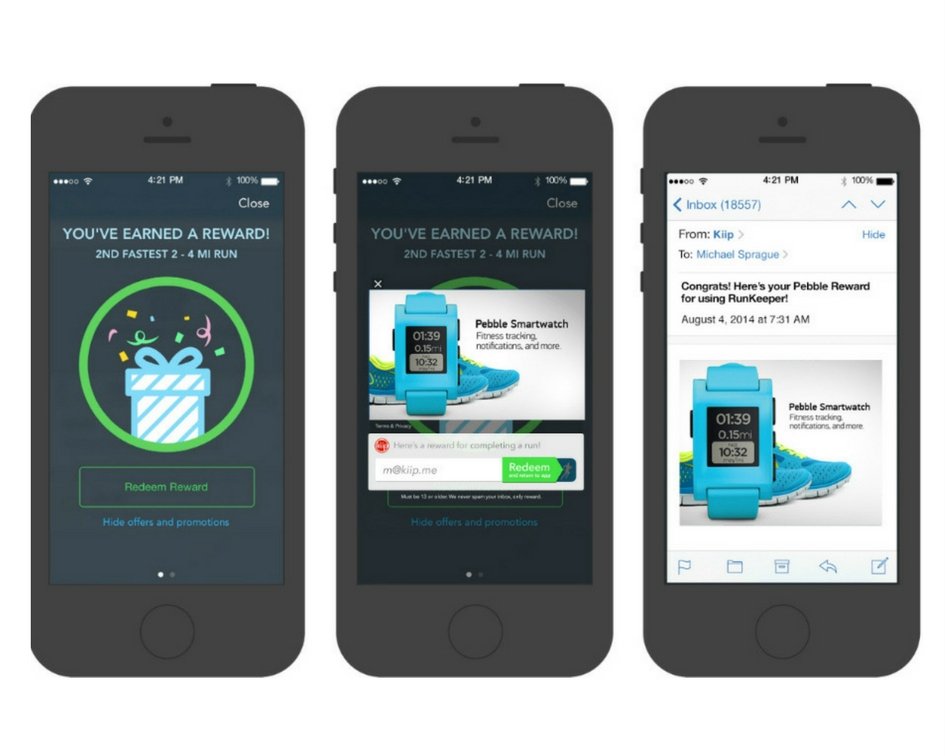
In-app sponsorship realized in RunKeeper
Examples: RunKeeper, Gayot.Free, with in-app purchases
In-app purchases mean that your product provides physical or virtual goods sales. You can sell everything from clothes and food to an in-game currency. This revenue strategy works well for eCommerce and mCommerce brands but is also flexible enough for other verticals. In-app purchase monetization strategy can include affiliate programs and partnerships as additional revenue streams.Examples: VSCO, Meet me.
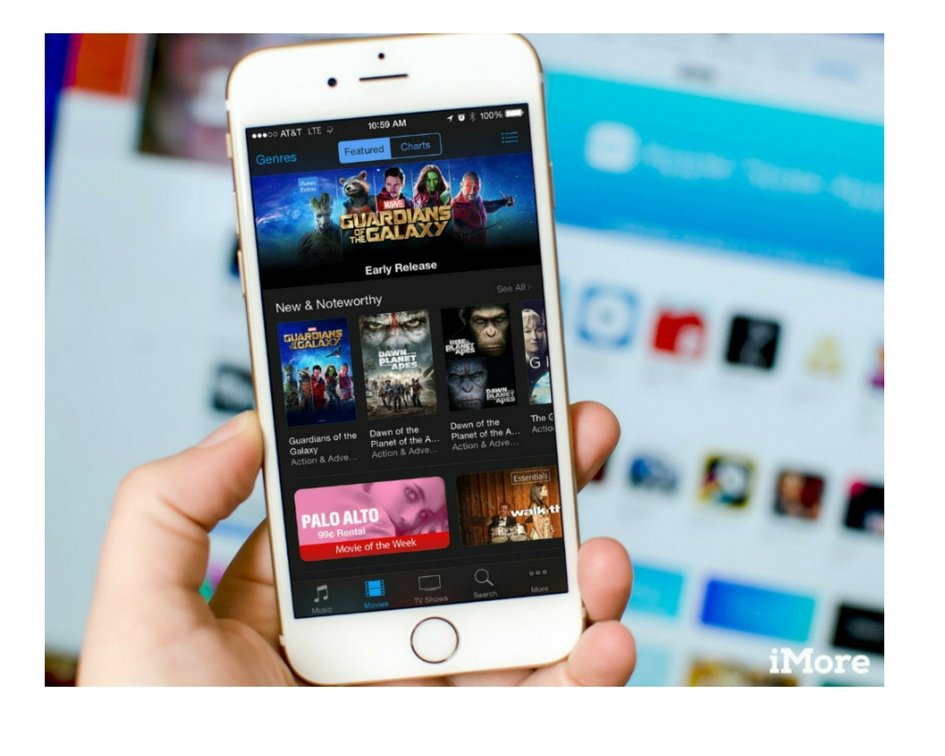
In-app purchases
Subscriptions
Subscriptions monetization is based on a subscription license. It means that customers pay a per-user fee, either monthly or annually, which allows them to use the software during the subscription term. Users lease the software instead of buying it.The subscription payment includes not only software licenses, but also support services and new versions of the software as they are released. There are several possible options for the subscription model.
Standard subscription. Users have to subscribe to use the service and pay a one-time introductory price for a specific duration.
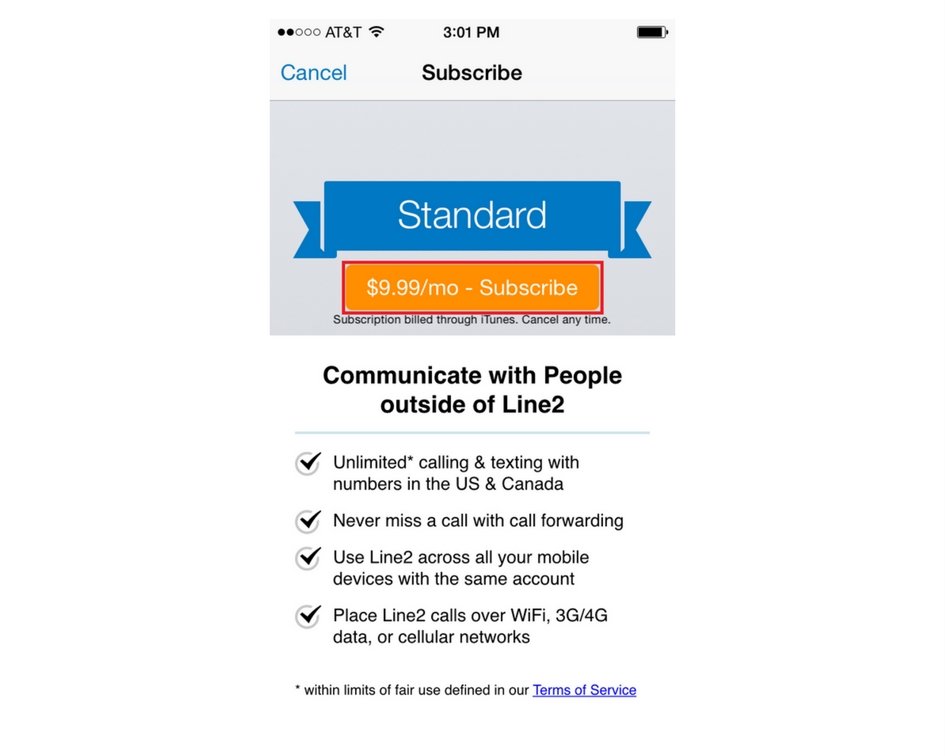
Standard subscription in iTunes
Examples: Financial Times, SalesForce.Free trial. Users can play with a product for a specified time and then decide whether they should pay for a subscription. The access is provided immediately but it won’t be billed until the free trial period is over.

Free trial subscription
Examples: Adobe Creative Cloud, Netflix.Freemium. The freemium monetization stream is a subscription subtype that represents the combination of free and paid (premium) versions. It’s a free service with the option to get access to paid, premium, or an advanced version with additional features. Everyone has free access to basic product functionality, and there is a charge for additional capabilities. The main goal of this model is to attract people and show them what your product can do and the value they can receive from it. The purpose of the free version is to provide a great user experience and to build relationships with customers so they will want to pay for additional tools.
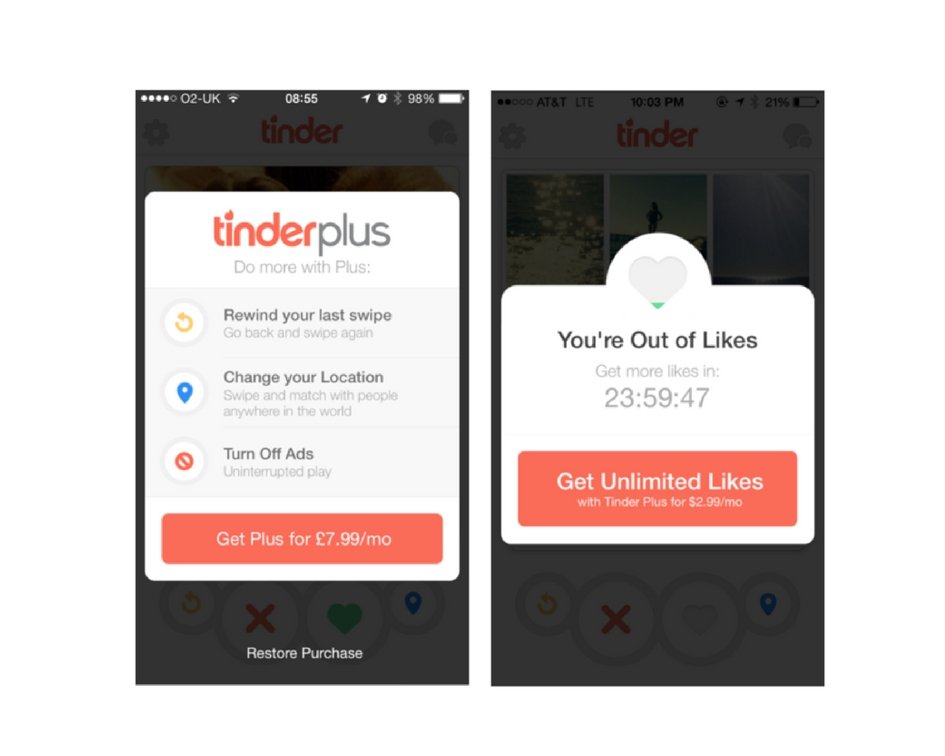
Tinder has a freemium version that can be upgraded to get broader feature-support
Examples: Grammarly, Tinder, Zapier.A subscription objective is to retain customers under a long-term contract and secure monthly/weekly/annual revenue flow. The customer should renew a subscription license at the end of each term, or lose the right to use the software. Subscriptions are common for all types of digital content: - software, gaming, newspaper, or streaming. If you run magazine, news, or video streaming apps that can limit content, it will be the most suitable means of monetization.
Sometimes, subscriptions can be combined with usage-based payments. For instance, MailChimp suggests subscription-based payments but their types depend on the number of people you reach out to in mail campaigns and the number of emails you send monthly.
Usage-based license
A usage-based license is often employed in B2B products. It means that clients subscribe to “a pay-as-you-go” license based upon some measure of consumption, paying for only what they use. That metric could be tied to different usage aspects such as registrations, enrollments, purchases, course completions, certificate completions, franchise locations, and even logging onto the system.For instance, Amazon Lambda, PaaS service for software development, provides up to 1 million free requests per month and then the company charges for every request or makes charges depending on the amount of memory a user consumes.
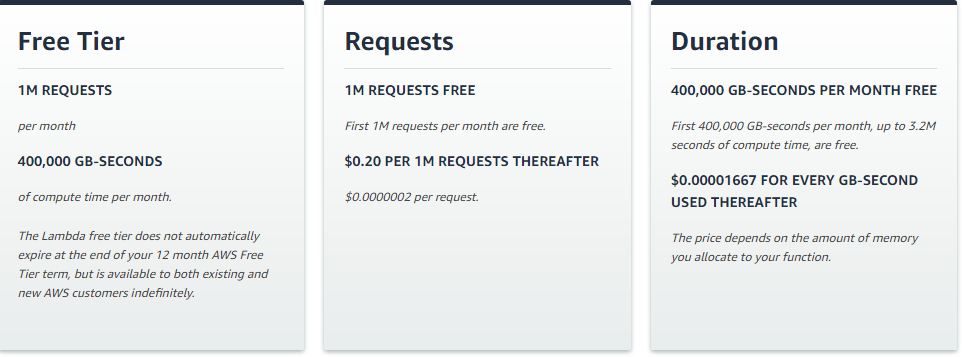
Usage-based license Lambda Amazon Web Service
Examples: Amazon Lambda, MailChimp (pay as you go plan), Shutterstock.Transaction Fee
The transaction fee system is one in which the company charges a commission based on volume for enabling or executing transactions. The amount of the transaction fee can be both a percentage or a flat fee.This model is the most useful for providers because they are not charged anything before they get some value from the marketplace. On the other hand, the marketplace get a piece of all the value that passes through the platform. This revenue stream requires an engaged audience using the marketplace or service because the goods or services become more valuable when more people use them. It’s easy to predict monetization income from a transactions fee revenue stream.Examples: Airbnb, Uber, eBay.
Extra charge for enterprise services, support, and consulting
This is a revenue stream that involves getting an extra fee for providing special services for corporate clients. Such companies have special requirements for software products that need to be customized only for them. Famous open source software companies Red Hat and Hortonworks leverage support and consulting services as their main monetization streams.Business model interaction
Broadly, there are two types of business model interactions you can use to build your business: the one-to-many business model interaction and the many-to-many business model interaction.One-to-many business model interaction one in which companies create products and services, develop and evolve them, and sell to customers. Most eCommerce stores and software products work according to this value model.
Examples: Adobe Creative Cloud, Buzzsumo, Microsoft Office, Gmail
Many-to-many business model interaction allows one group of users (producers) to create and consume value on the platform for the other group of users (consumers) to consume.
Examples: Wikipedia, Uber, AliExpress, Google search engine
These two types have fundamentally different strategies of creating products. The one-to-many business model interaction approach requires companies build products with the end consumer only in mind. On the contrary, the many-to-many value model requires being mindful of both producers and consumers. For example, YouTube requires building tools for producers - video hosting on YouTube - and for consumers - video viewing.
Each model has its own strategy. In the case of the one-to-many business model interaction, users interact with software that is created. So, the product is valuable itself. The many-to-many business model interaction allows users to interact with each other using software that the company creates. As a result, the product has no value unless there’s a community of producers and consumers around it.
Closing thoughts
As high-speed Internet connection becomes common globally, different business and revenue models blend. On-premise software can now be combined with cloud SaaS and work on a subscription basis, as proven by Adobe Creative Cloud products. Thus, a business model doesn’t place many limitations in terms of choosing revenue streams. But the nature of market and customer expectations are changing as well. What specifics should be kept in mind when choosing the business model characteristics and revenue streams for your business?- Proliferation of freemium services. As competition both in B2C and B2B segments is tense, users expect to receive the core features for free or they'll consider competitors. So, the product should provide quite unique experiences and services to mass consumers to be distributed for a license or subscription only. For instance, the media and entertainment industry hold up as every movie or a video game is expected to deliver a unique experience. This can’t be said about lifestyle management, time management, and messaging apps.
- Cloud surge in the corporate sector. Enterprise mobility and BYOD (bring your own device) trends have become common in the corporate sector. People tend to use their corporate software from any device, blending work and leisure lifestyles. Making B2B and corporate software cloud accessible is no longer a foregone conclusion.
- Personalization and precise ad targeting. Advertising in applications hasn’t gone anywhere, but selling ads space isn’t enough. Users expect to see personalized ads based on their previous interactions with the web. While making your own ad personalization is expensive, using such services as AdSense from Google is a good option to make ads more valuable to customers.

